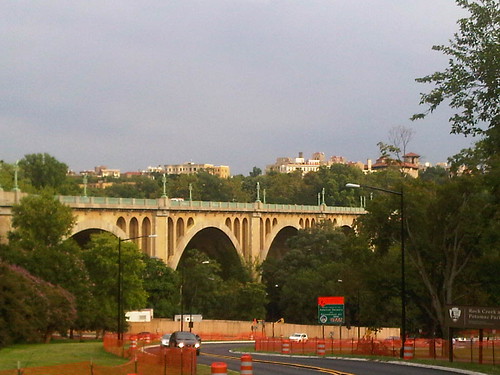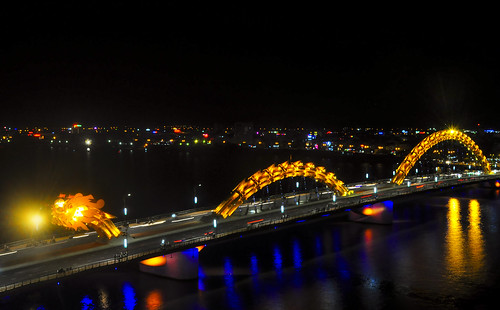Transportation bridges as an element of civic architecture, urban design and placemaking
I use the example of the Tempe light rail bridge a bunch as an example of how transportation infrastructure can be an element of civic architecture rather than merely an enabler of conveyance.
In the DC context, spurred on by my involvement in the 11th Street Bridge Park project, I wrote a piece ("Anacostia River and considering the bridges as a unit and as a premier element of public art and civic architecture") suggesting that DC Department of Transportation consider the city's bridges in unison and make aesthetic attractiveness a key element in the design and construction of the city's bridges.
Now that bridge design is the precinct of the local department of transportation, DC doesn't take this kind of approach, which was typical during the time when the federal government ran the city. By contrast, in cities like San Francisco and New York City high quality bridge design has become a key element of community visual identity and brand--the Golden Gate Bridge in San Francisco and the Brooklyn Bridge are in fact internationally known landmarks.
 Flickr photo of the Connecticut Avenue Bridge by Jon D.
Flickr photo of the Connecticut Avenue Bridge by Jon D.DC has a mix of bridges in terms of their contribution to civic architecture. The older bridges constructed to cross city parks and rivers generally were constructed in a time when design mattered.
An example would be the Memorial Bridge between DC and Virginia or bridges crossing Rock Creek Park, especially the Connecticut Avenue Bridge.
The newer highway related bridges are utilitarian, and that includes the newest bridges, such as the 11th Street Bridge or the New York Avenue bridge across the Union Station railyard in Northeast DC. The latter bridge has a particularly hideous piece of "public art," at least compared to more signature design elements of bridges constructed elsewhere.
 Dublin Docklands - Samuel Beckett Bridge. Flickr photo by William Murphy.
Dublin Docklands - Samuel Beckett Bridge. Flickr photo by William Murphy.In terms of modern bridges, many cities are choosing to build new bridges that are visually distinctive, many designed as it happens by Santiago Calatrava.
The lighting company Philips works with communities in creating cost effective but stunning architectural lighting projects on bridges and one of the company's websites features some of these projects, including the Dragon Bridge in Da Nang, Vietnam, which is becoming a key element of the city's identity and a tourist attraction.

Dragon Bridge, Da Nang. Flickr photo by Nghi Nguyen.
Similarly, Philips has produced a great video on the relighting of the Harbor Bridge in Corpus Christi, Texas and how this is creating a new focal point and placemaking element within the community.
They have done many many great projects, including in Little Rock, Arkansas and Louisville, Kentucky among others.
But check out the Meydan bridges in Dubai.
Wow.
Labels: architectural lighting, civic architecture, public realm framework, transportation infrastructure, urban design/placemaking




15 Comments:
it is incredibly sad that the city and feds are going to land lock the Washington navy Yard - which could be leveraged to provide ship visits as they have done for 200 years now- and will no longer be able to do with the short bridge they are putting up for the Fred Douglass replacement. On the US Navy blogs people are really upset about this and see it as ignoring history and heritage- and the city has done very little to capitalize on this major asset that few cities possess here in the USA. Any place other than DC with our administration constantly chasing sports franchise owners - and not putting their eyes on the targets of other opportunities- would jump to fix this or not allow it to happen in the first place. This is ridiculous- the Barry should be replaced with another large ship and the bridge should be redesigned to allow access to all manner of ocean going vessels as it has for its entire lifespan.
http://news.usni.org/2015/02/25/washington-navy-yard-to-dismantle-display-ship-barry-by-next-summer-no-plans-for-replacement
I know about that. I don't know how that decision came about, whether or not the city tried to change it.
I am not sure how much the USS Barry has been open to the public. It is used by the DOD/Dept. of the Navy for various ceremonial activities.
Columbus IN has 2 nice bridges. It's a neat little town.
The Barry by itself is not the whole point- it is the fact that the Navy Yard has historically hosted visiting ships from around the world for its entire history and now this function will now be disabled completely. Not more than 10 years ago a whole flotilla of tall ships berthed at the Navy Yard attracting thousands of visitors. This is a powerful aspect of this city's culture that has been allowed to disappear completely. It is yet another example of how people mess up our local history and amenities from another place and then make the claim that "DC never had this or that". Now this crap happens yet again....
Of course Alexandria Virginia and Gaylord could always become "Washington DC" just as Reston Towne Centre has made this very claim...maybe the US Capitol should just be dismantled and moved over to Centreville.???????????
The Navy Yard and the Anacostia is a silted up port. DC's maritime role has been in decline almost since it began. Deal with it.
The developers at the Wharf are interested in bringing tall ships in.
BS
the Anacostia was only allowed to silt up after PCBs were discovered in the silt
You sound like an out of town or temp troll.
obviously there is no reverence or respect for the history of this place- god forbid this be allowed in New York , Boston or San Francisco. Yet those people all come here and claim we have nothing ever worth saving here that is of heritage quality. Maybe if we had a company other than Bechtel from California design our subway system we'd be better off.
interesting note that DC's maritime role has "been in decline since it began" I wonder if this troll has ever read the book "From Round shot to Rockets" ? It talks all about the multitude of large ocean going vessels that once plied the Anacostia River right up until the gun factory closed in 1963. Large ocean going vessels. This is not indicative of "decline since it began" it speaks of heavy industry that for various reasons was moved off of the banks of this river at a much later time .
hey, watch the language... it's fine to criticize arguments, I'd prefer people didn't criticize each other, call people stupid etc.
2. wrt The Wharf my understanding is that yes, they do want to attract ships as attractions. To be honest, I am not sure what the clearances are on the various Potomac River bridges.
WRT the Anacostia, again, I am no expert, but my understanding is that northeast of the 11th Street bridges, the depth is minimal, because "there isn't enough water coming into the river" from Maryland. Maryland too is a source of a lot of the pollution in the river. I don't know about how the PCBs came into it.
I haven't read Wennersten's books about the river...
WRT the Navy and ships at the Navy Yard, it'd be worth asking them why they aren't interested, because I imagine if they were interested in keeping/bringing large ships to the waterfront there, they would continue to do so.
the PCBs came from both the Benning Road power plant and the gun factory operations. PCBs were used as a lubricant during milling operations in the foundries. They would bore gigantic rifling threads into cannon barrels and just dump they dirty or used lubricants in the drink. There is also supposed to be radioactive waste that was covered over at the Maritime center- they just built a platform right over it. BTW- the troll that was attacking my comments earlier is obviously not well informed at all
Historically the river had a deep water channel all the way to Bladensburg Maryland. Mostly the channel was kept up and maintained for the large ships right up to 11th street and there was little need otherwise except for coal barges which still ply these waters especially during winter months.
where would coal barges go as for many years the PEPCO "plant" hasn't been in operation. Similarly, wrt a channel being maintained up to Bladensburg, why would that be given it is no longer a port. E.g., the thing about the river silting up as a result of the wasting away of soil from tobacco production.
This Wennersten book is specifically on the Anacostia. I guess I should track it down.
http://www.amazon.com/Anacostia-Death-Life-American-River/dp/0963515969/ref=asap_bc?ie=UTF8
interesting - I did not see that other Wennerstein book- I was thinking of another one and it left out much it could have about the Navy Yard . The channel was left to silt up by the late to middle 1800's but originally it was deep water all the way to Bladensburg which was both a tobacco and naval port in the earliest days of the republic. Yes- Bladensburg's access was cut off and the army corps of engineers did some dredging in the early 20th century to create Kingman Island and fill in some of the mosquito areas by what is now the stadium- but make no mistake ships did at one time go to Maryland this route. Yes soil erosion was one of the culprits filling in the river upstream. Sadly much of old Bladensburg was destroyed- it was a fairly significant town for the times.
I have myself seen coal barges float up to the Benning Road plant in recent years. It is still accessible by water for these purposes. The interesting thing about the W Navy Yard was that the river was large and deep enough to turn a ship around in - people look at it now and think it was always the way it is now and are not capable of visualizing the past glories. I once talked to a navy diver [ my dad was also a navy diver] and he was working at the navy dive center there on the docks when the 11th street bridge was being built in the late 50's- the guys saw a man jump off the bridge and they went out as fast as they could in a small boat and tried to save him- he said they wound up finding his body instead. My dad's family worked at the navy yard for much of the period from 1799 until WW2. Even then my dad had dealings with the diving research unit once located there. Few people are aware of this history and seem to make light of it w/o any basis.
Links:
http://www.curbsideclassic.com/blog/the-automobile-and-the-american-road-bridge-part-1/
http://www.curbsideclassic.com/blog/the-automobile-and-the-american-road-bridge-part-2/
I'll note that design stopped being part of the build equation when the flood of highway money came in.
Off topic:
http://www.slate.com/articles/business/metropolis/2015/09/european_heritage_days_in_paris_it_s_an_amazing_way_to_experience_a_city.html
Post a Comment
<< Home